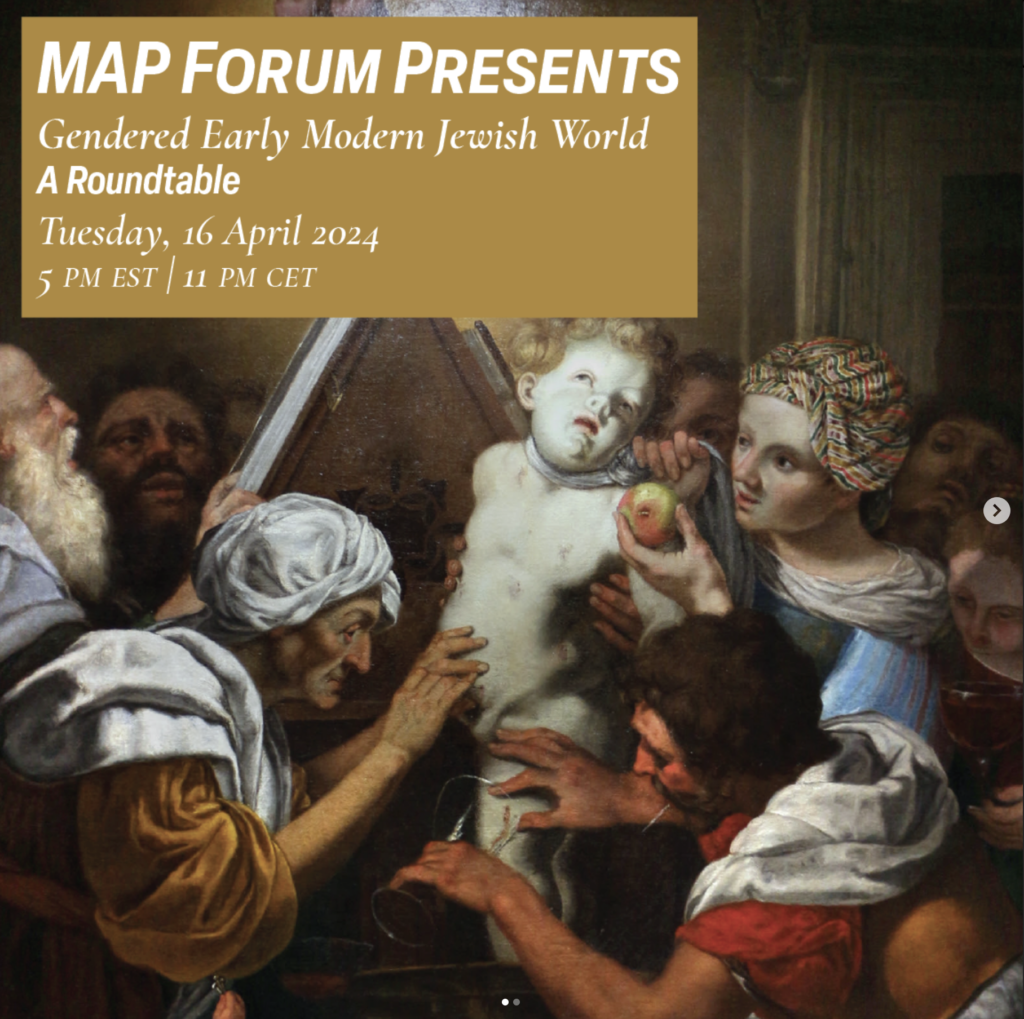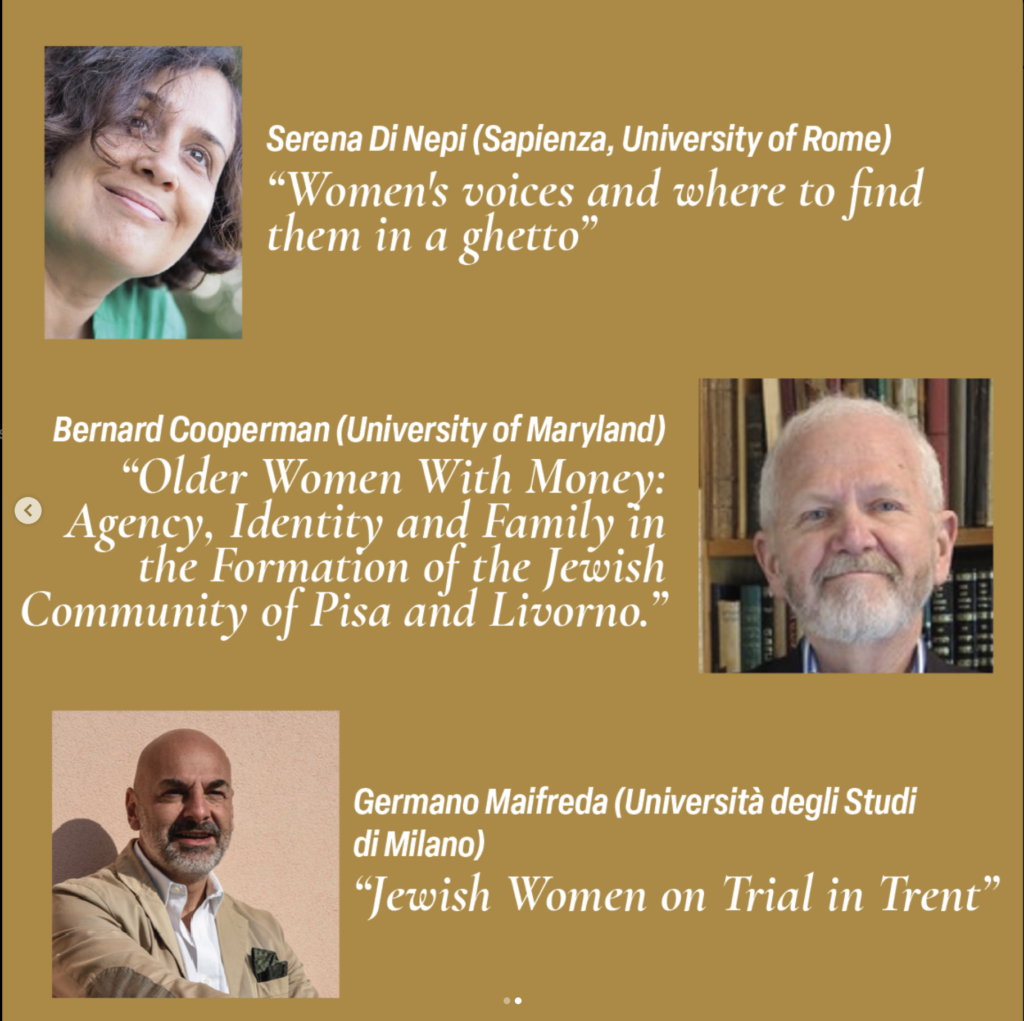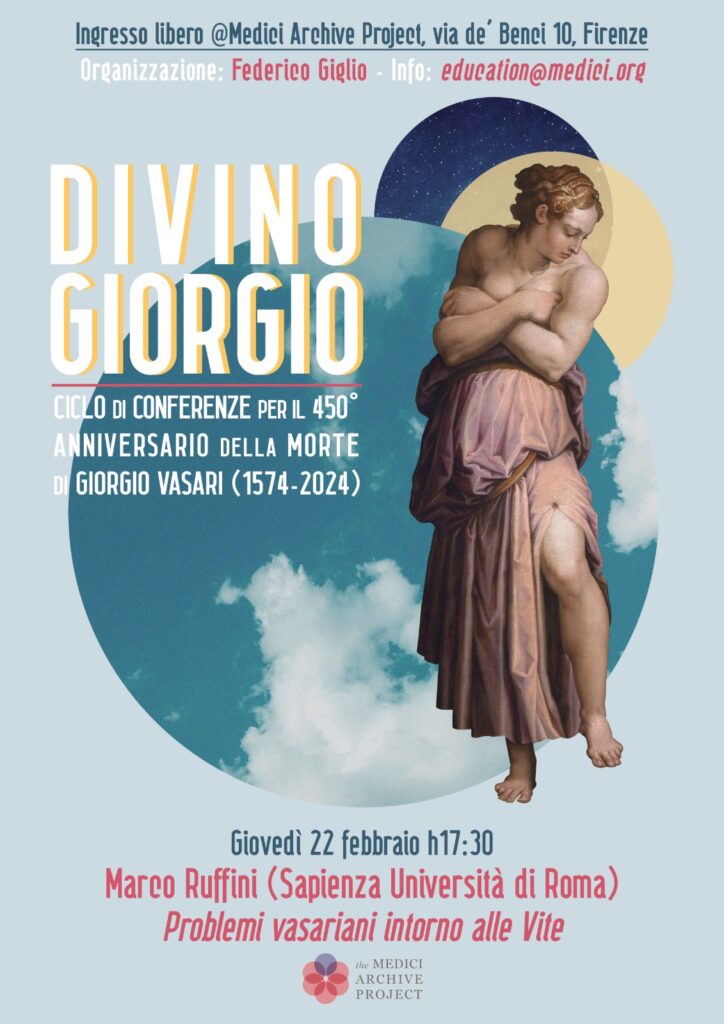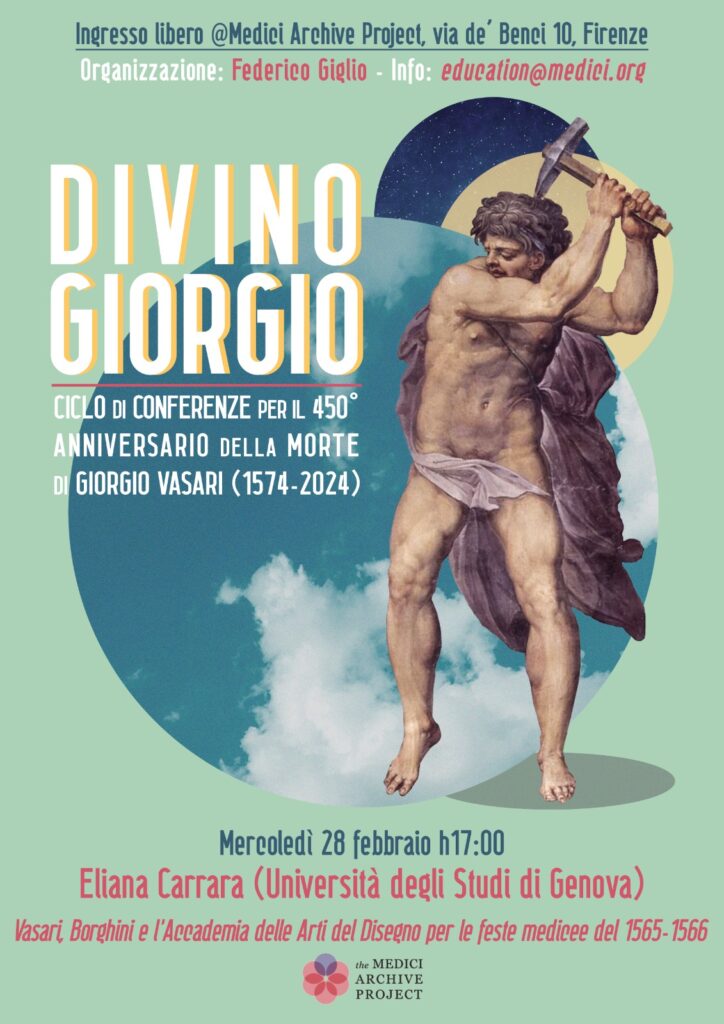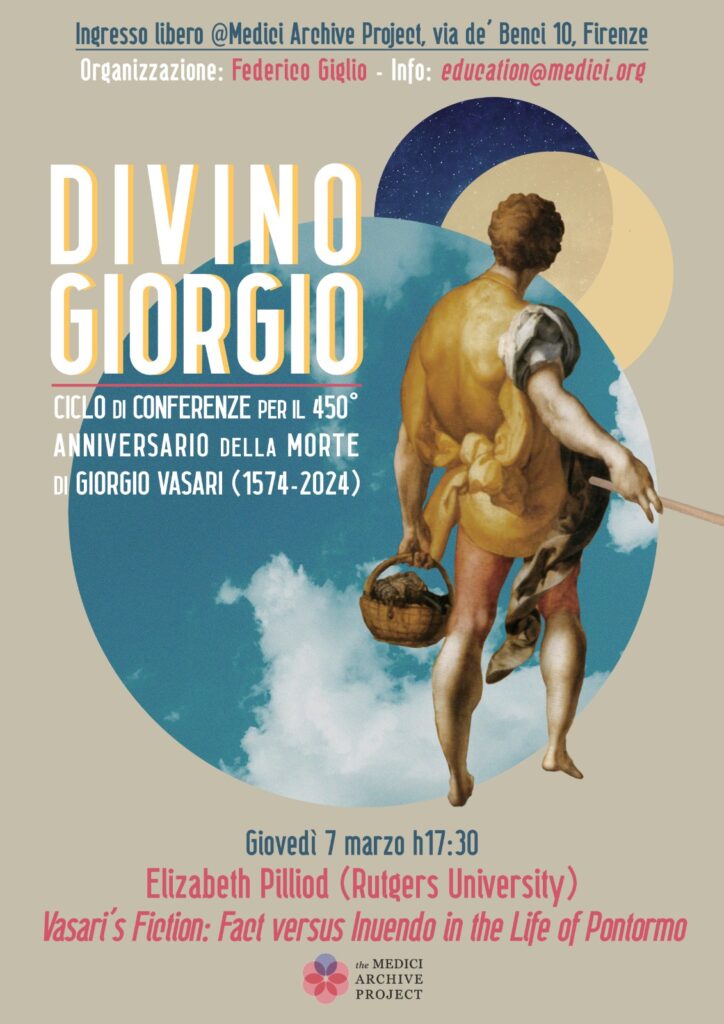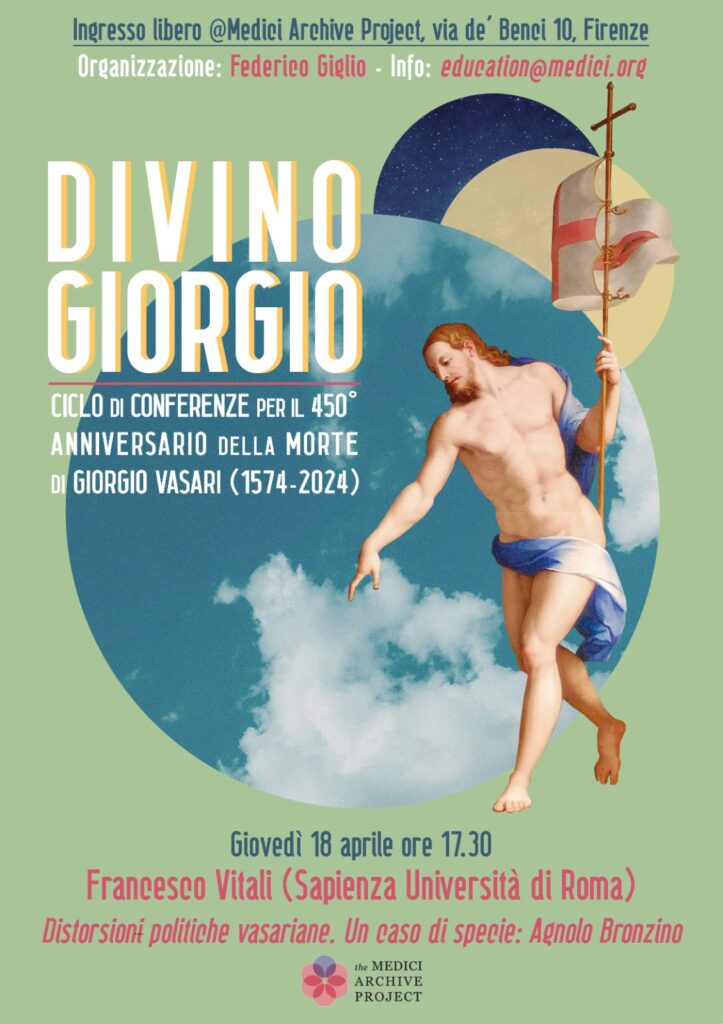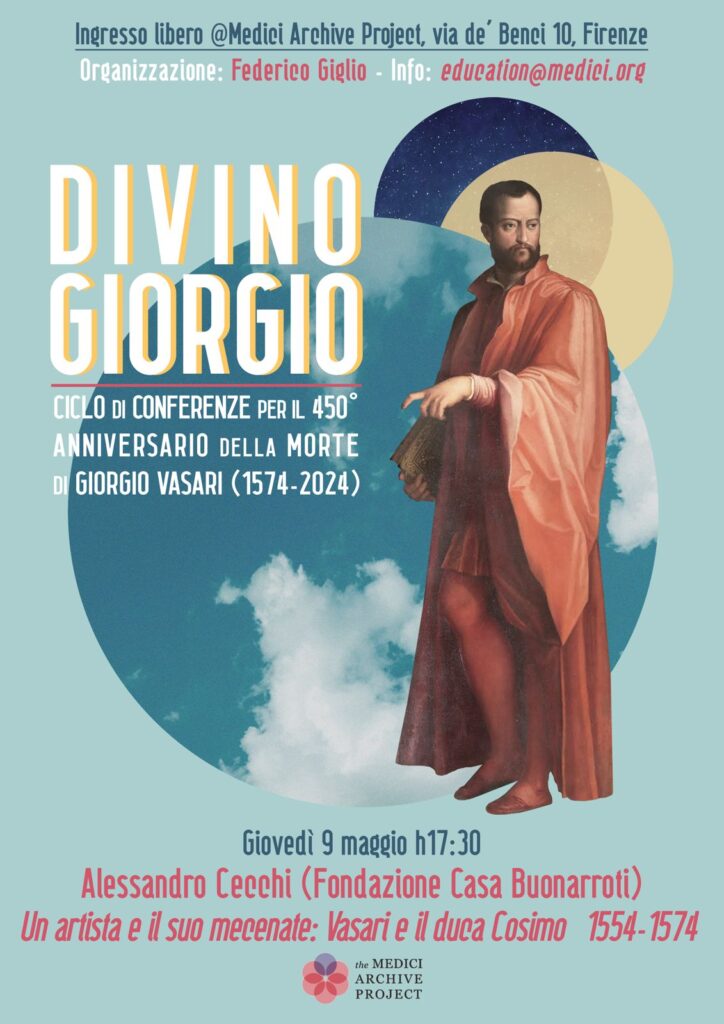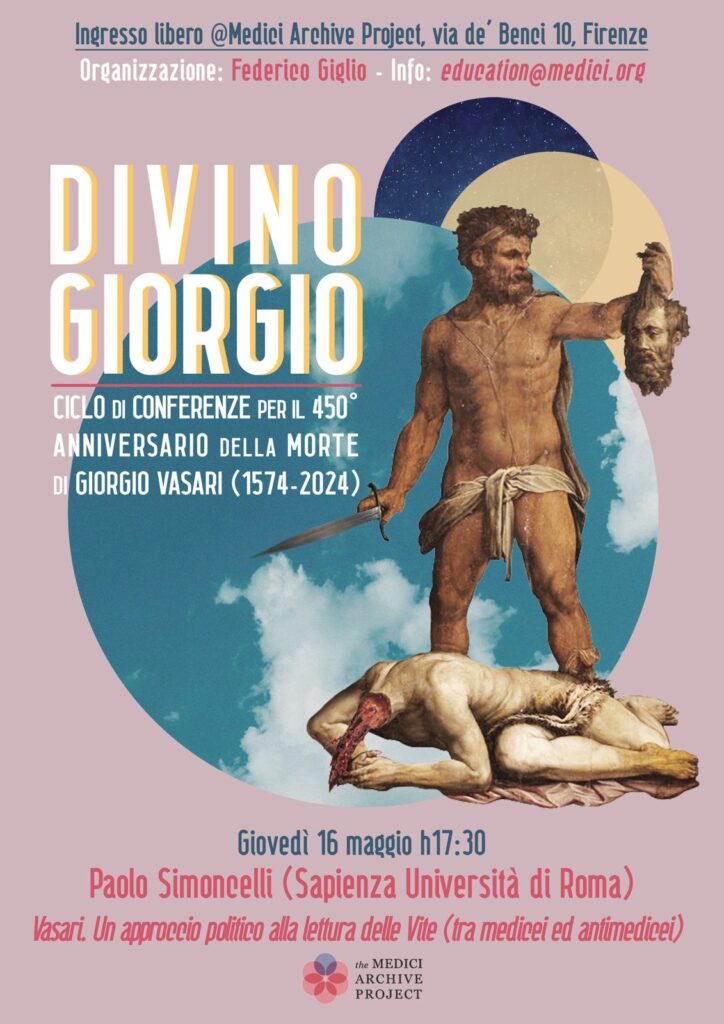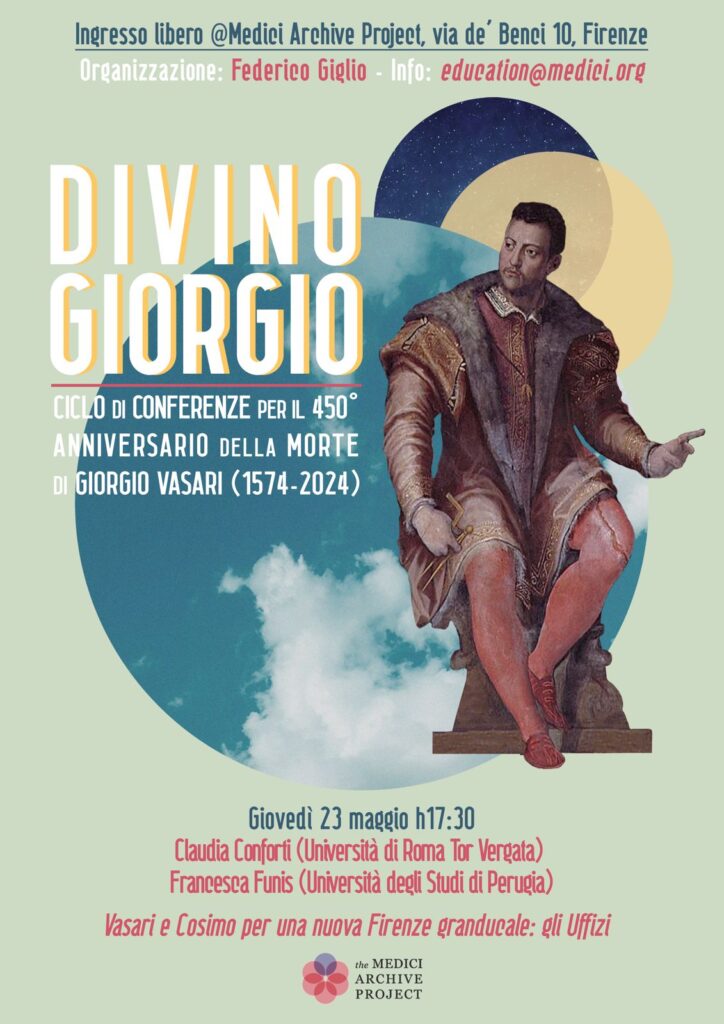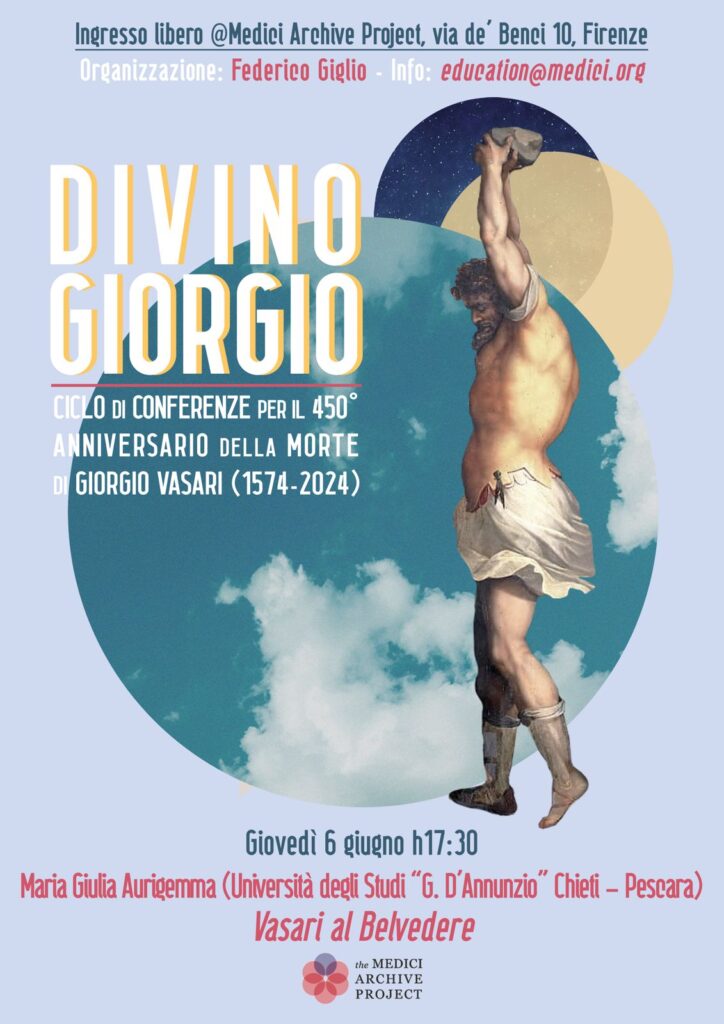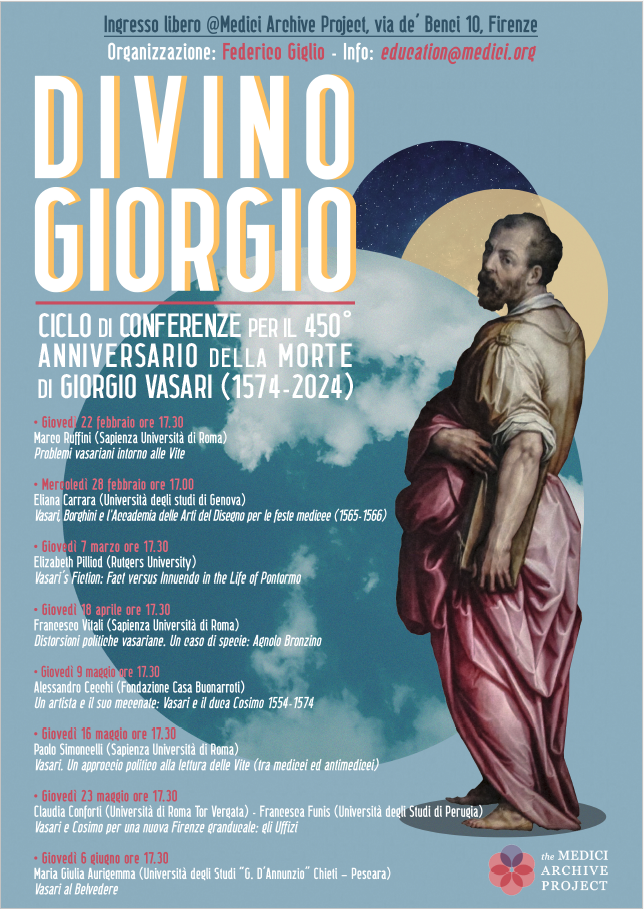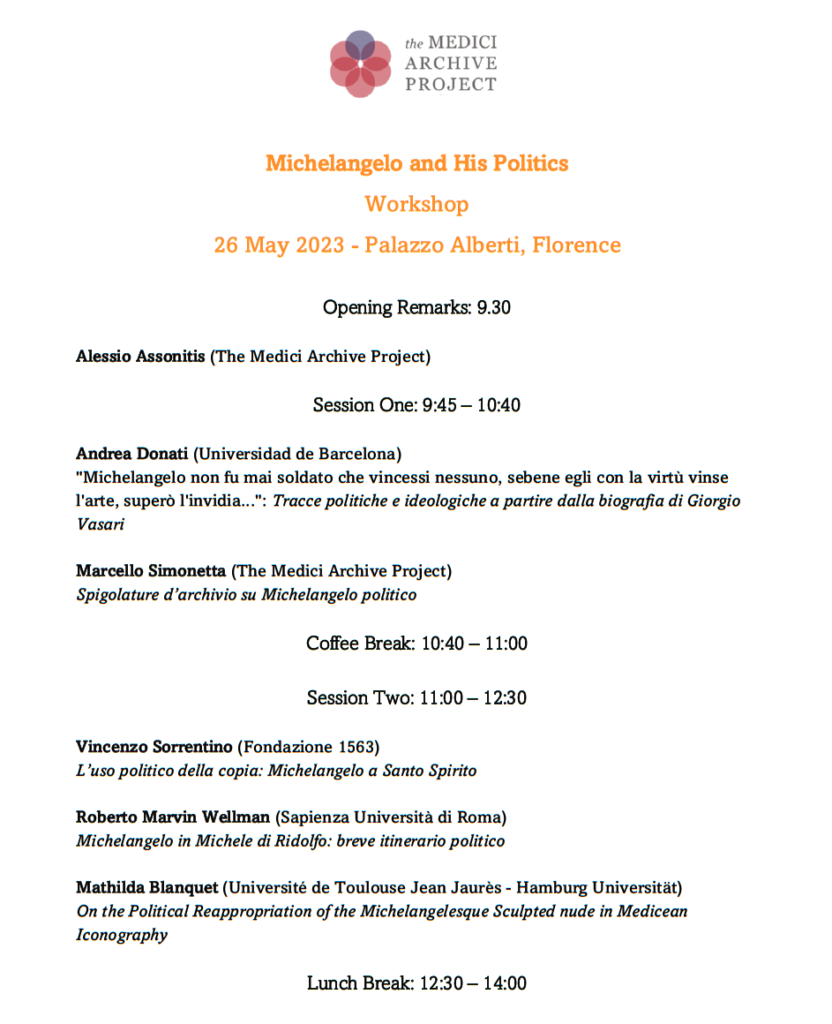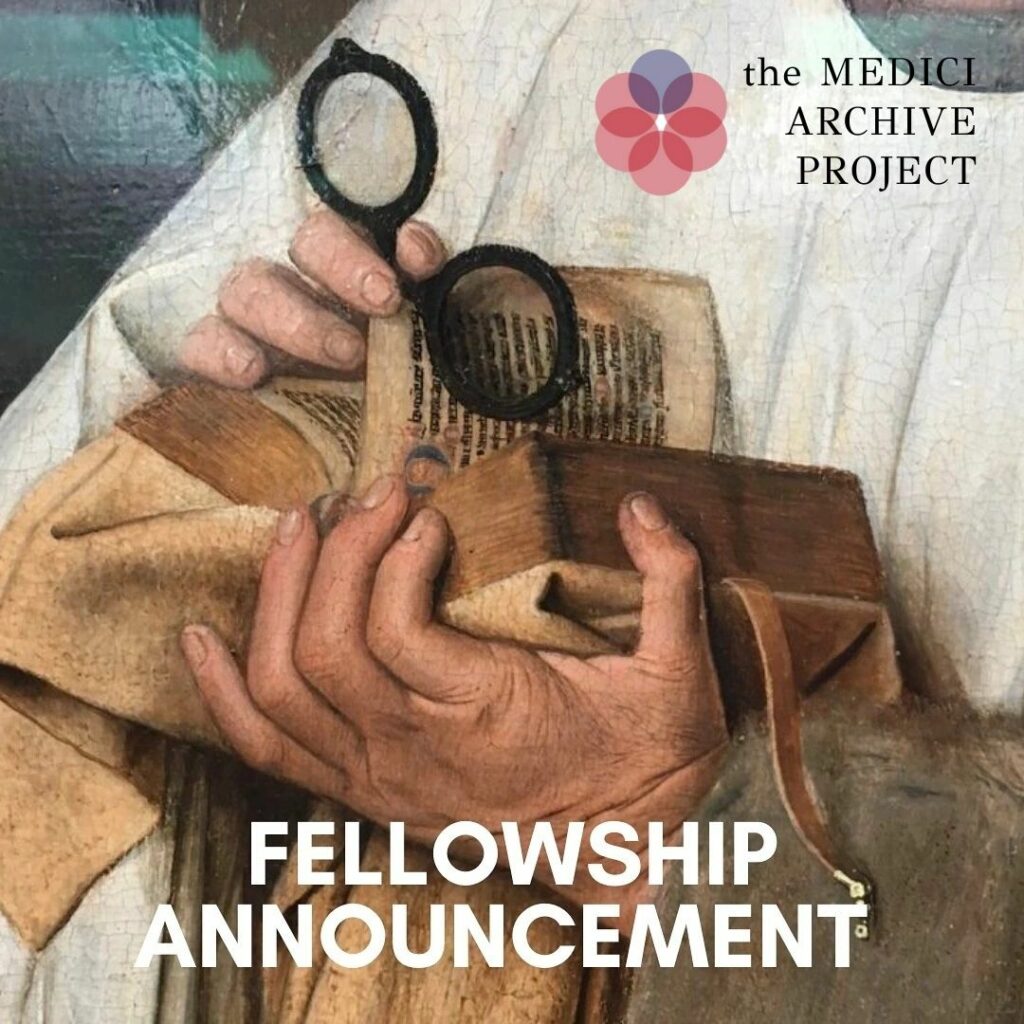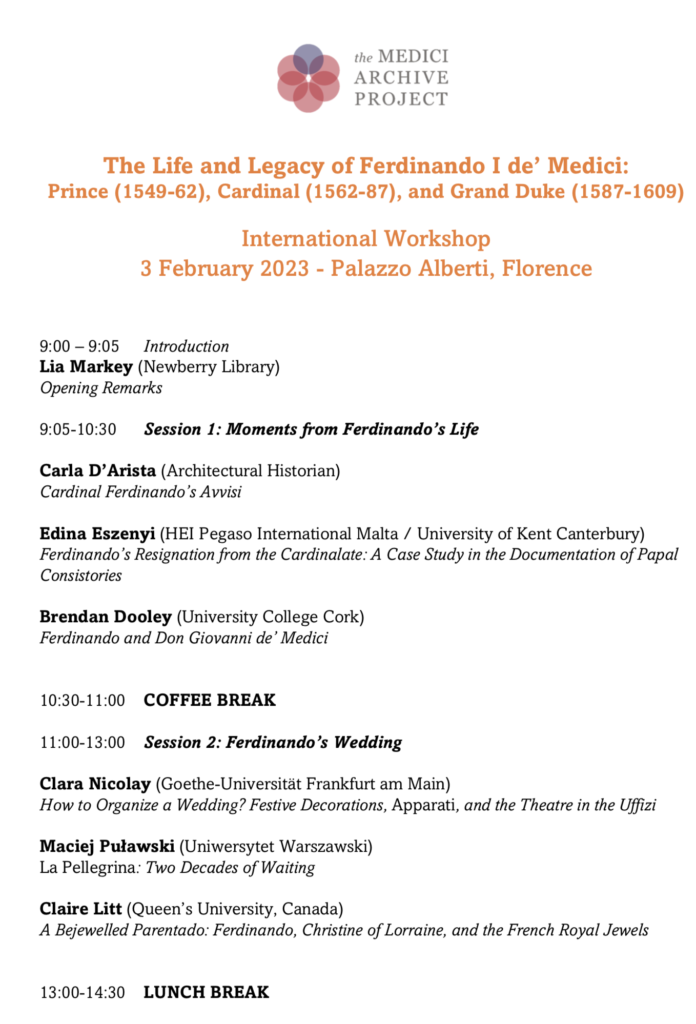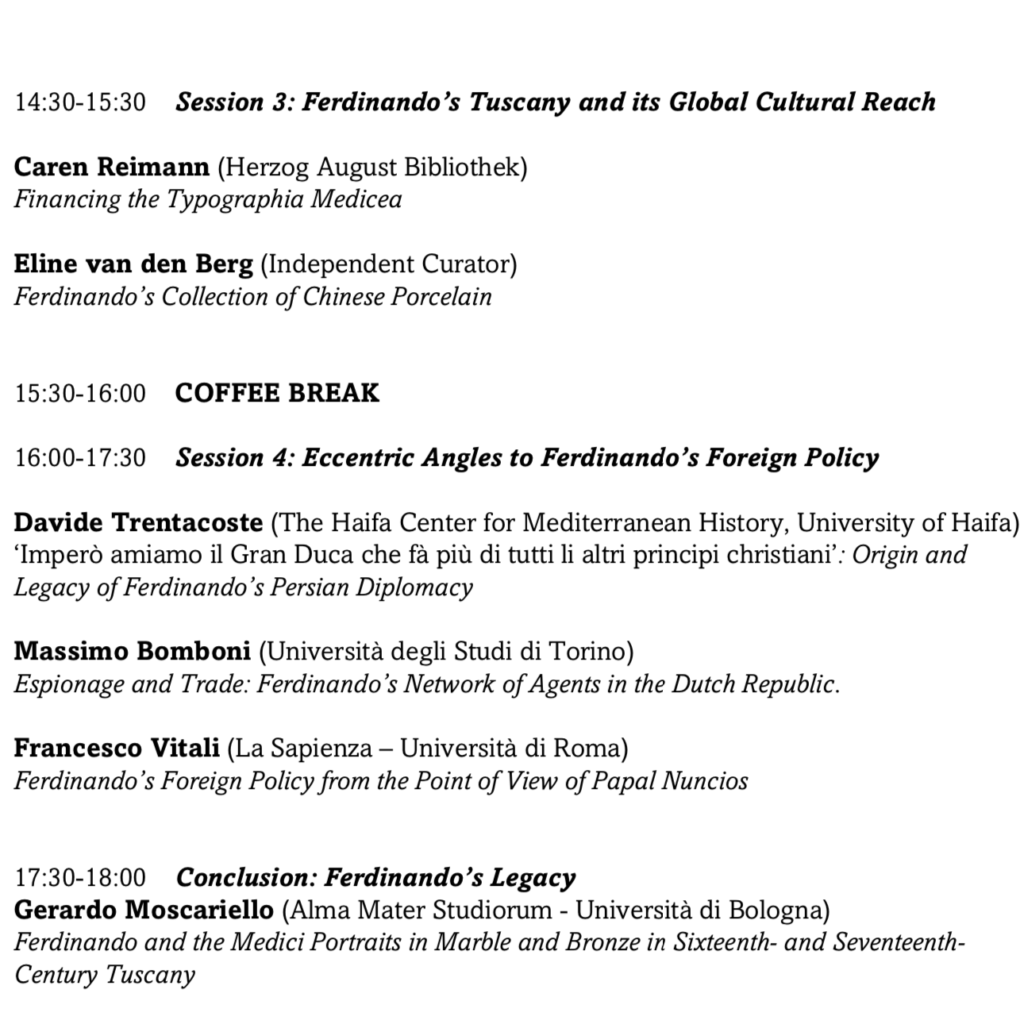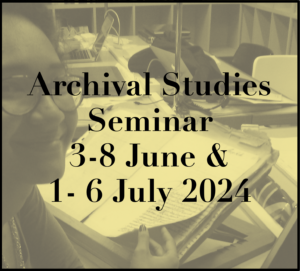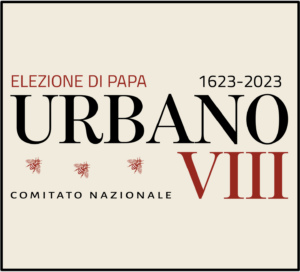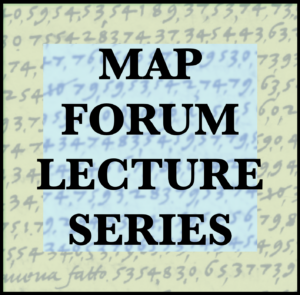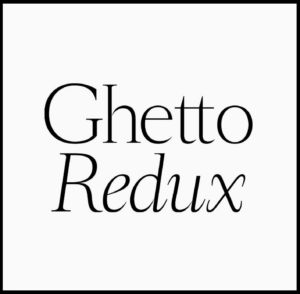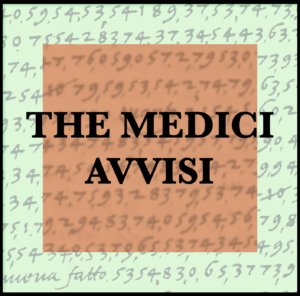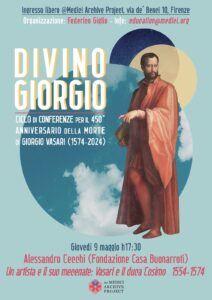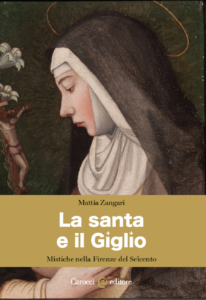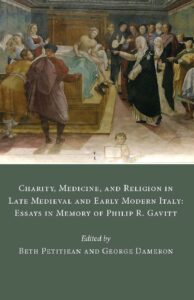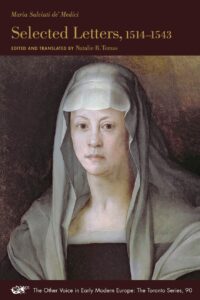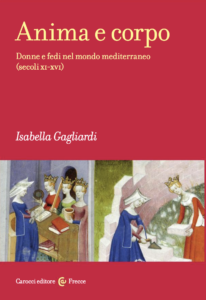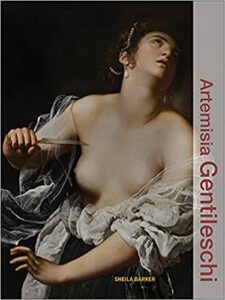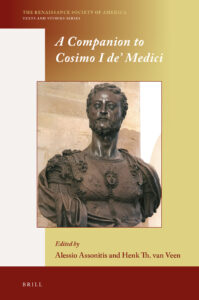Search Results for:
URBANO VIII 1623—2023
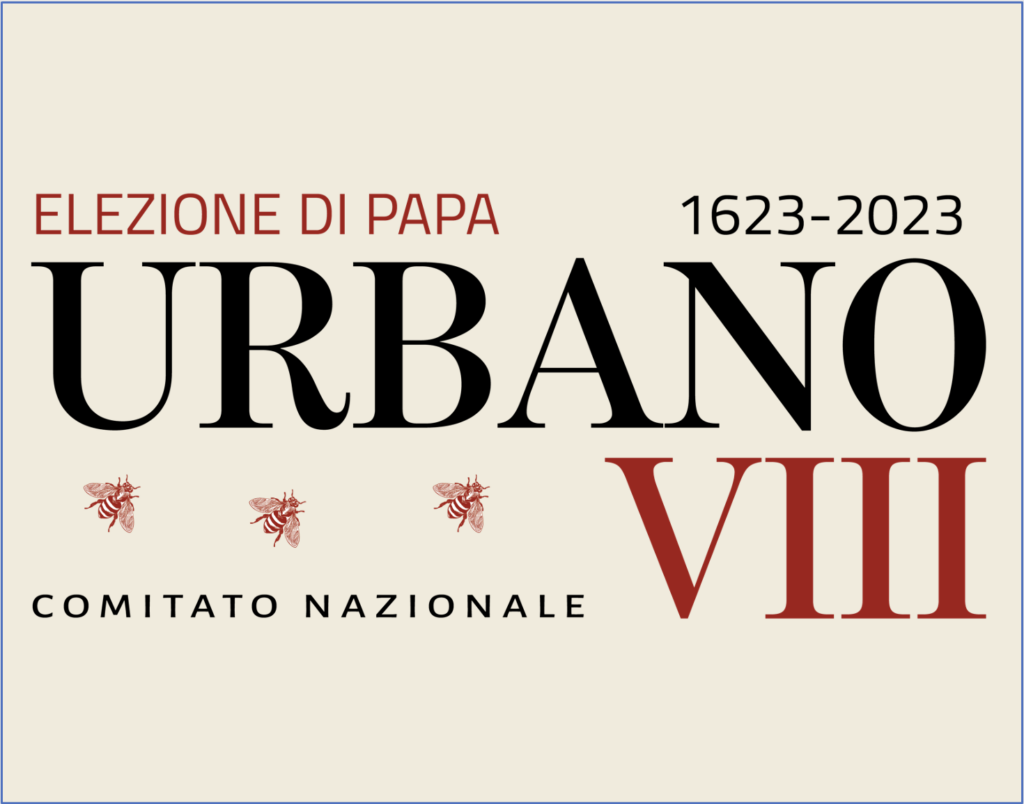
Eventi & Iniviative
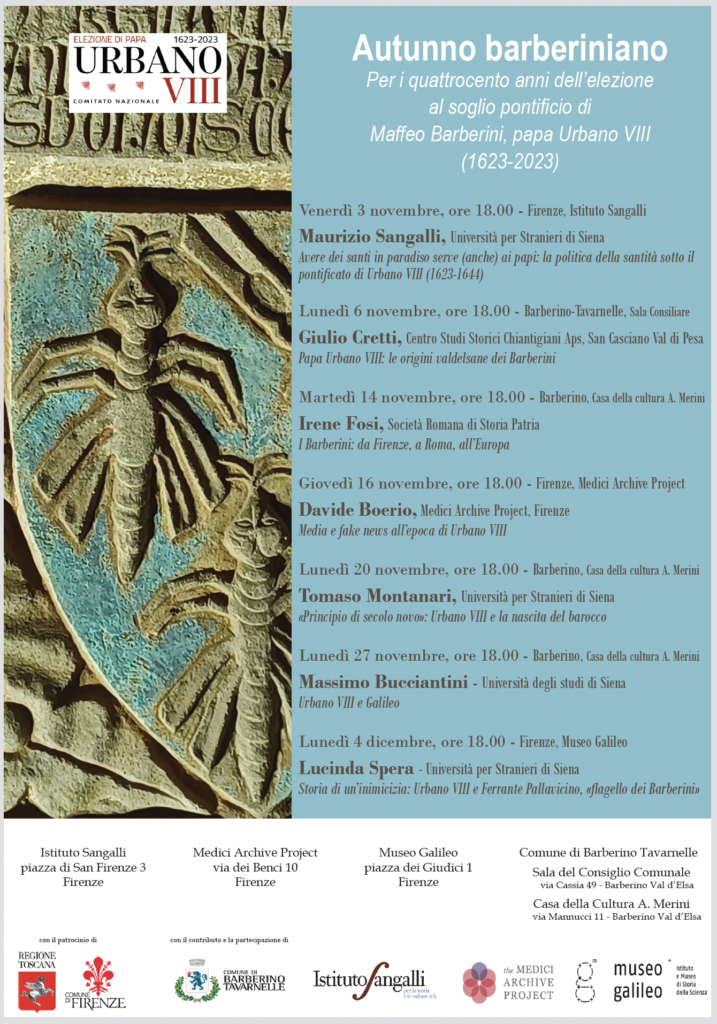
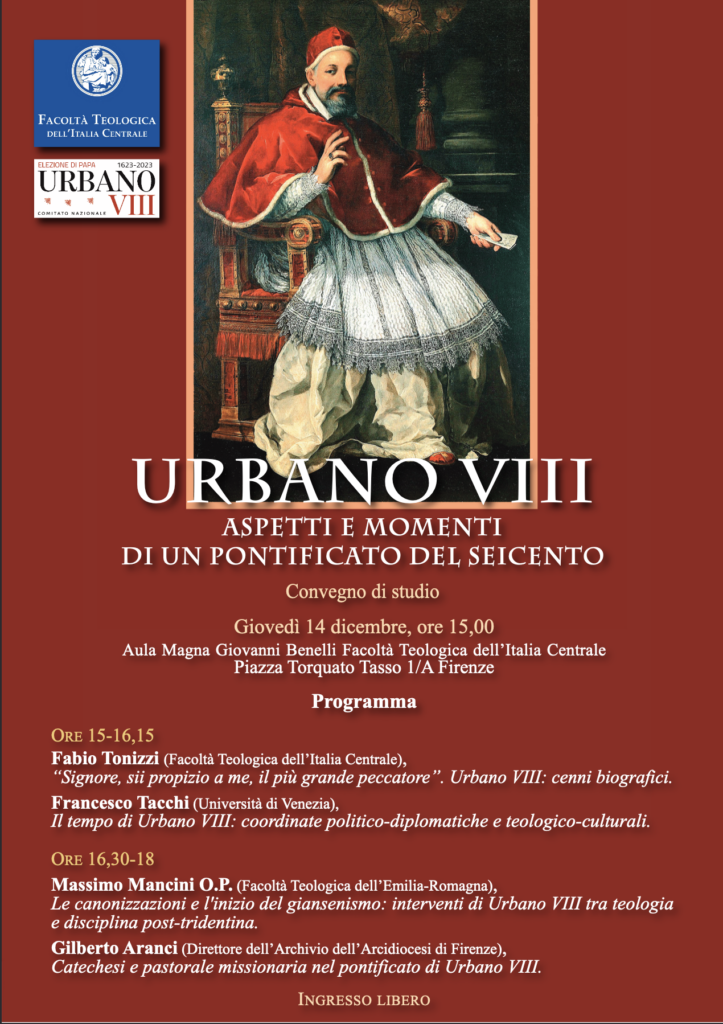
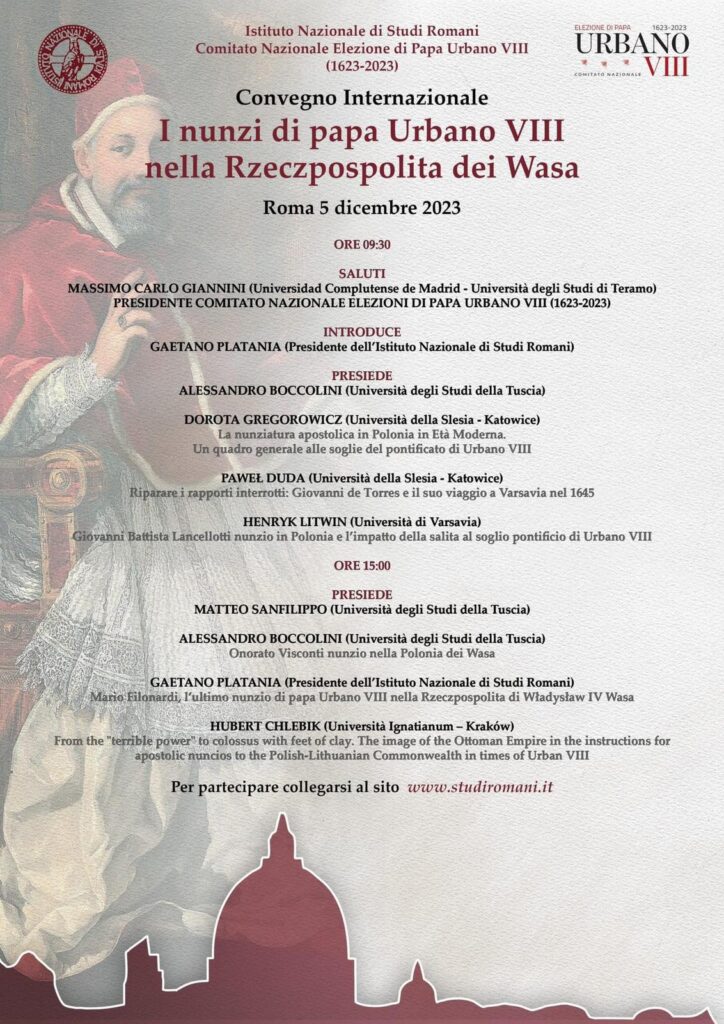
Verbali
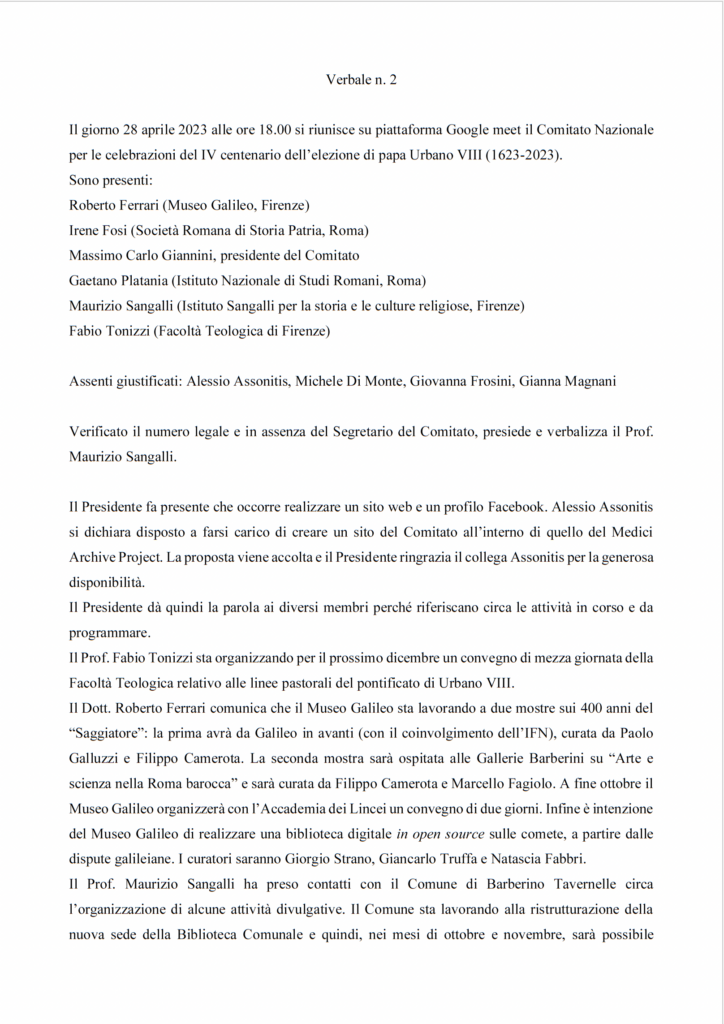
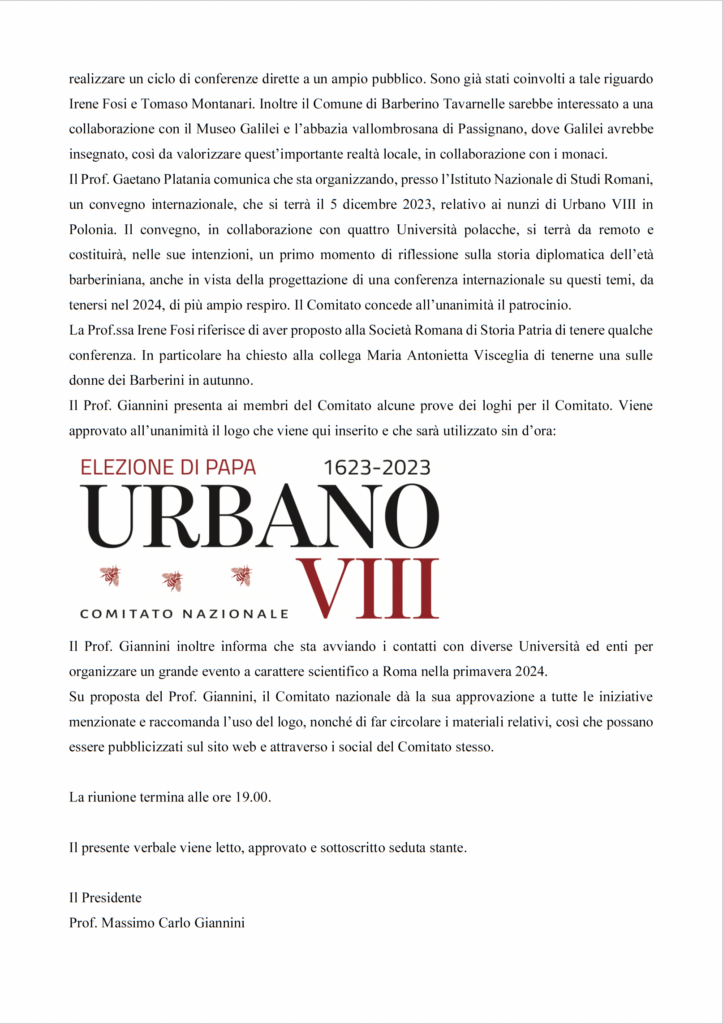
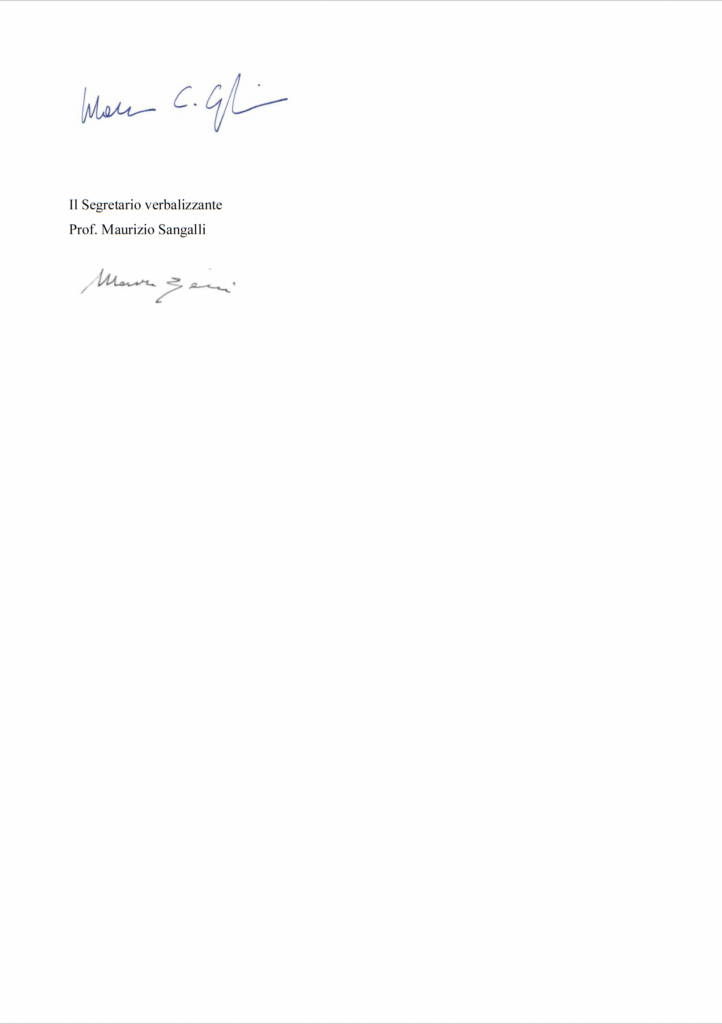
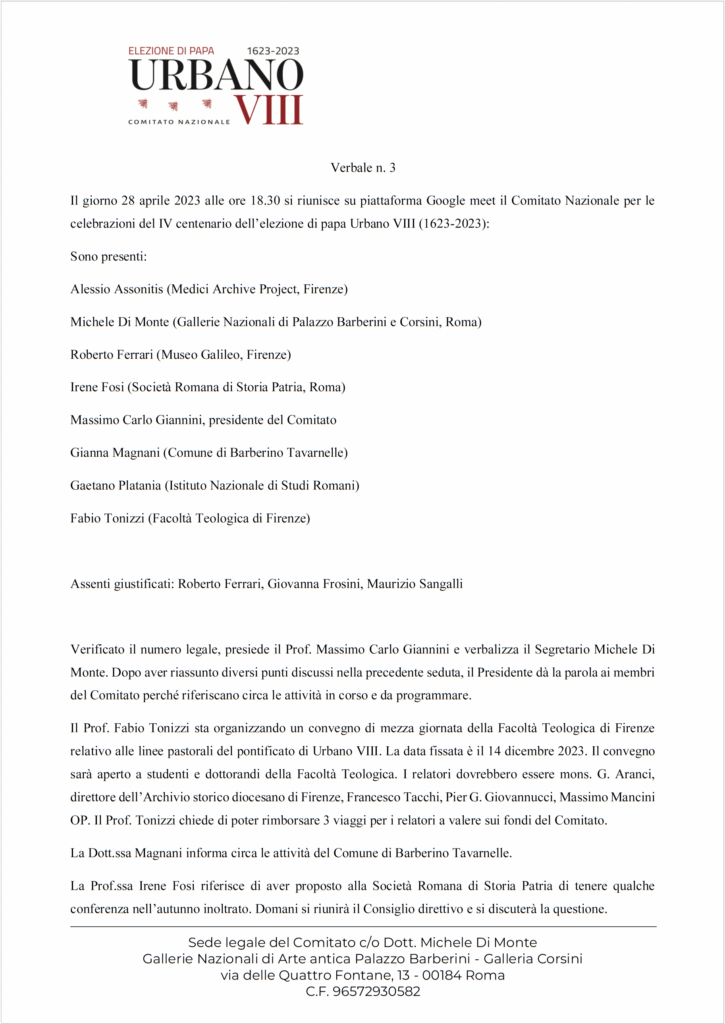
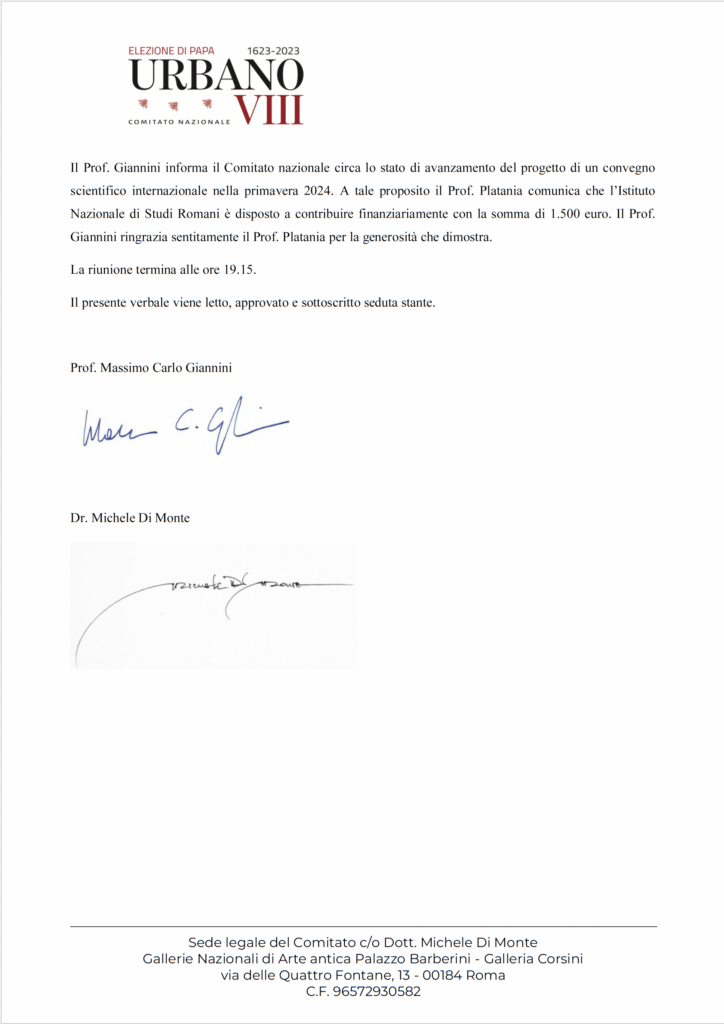
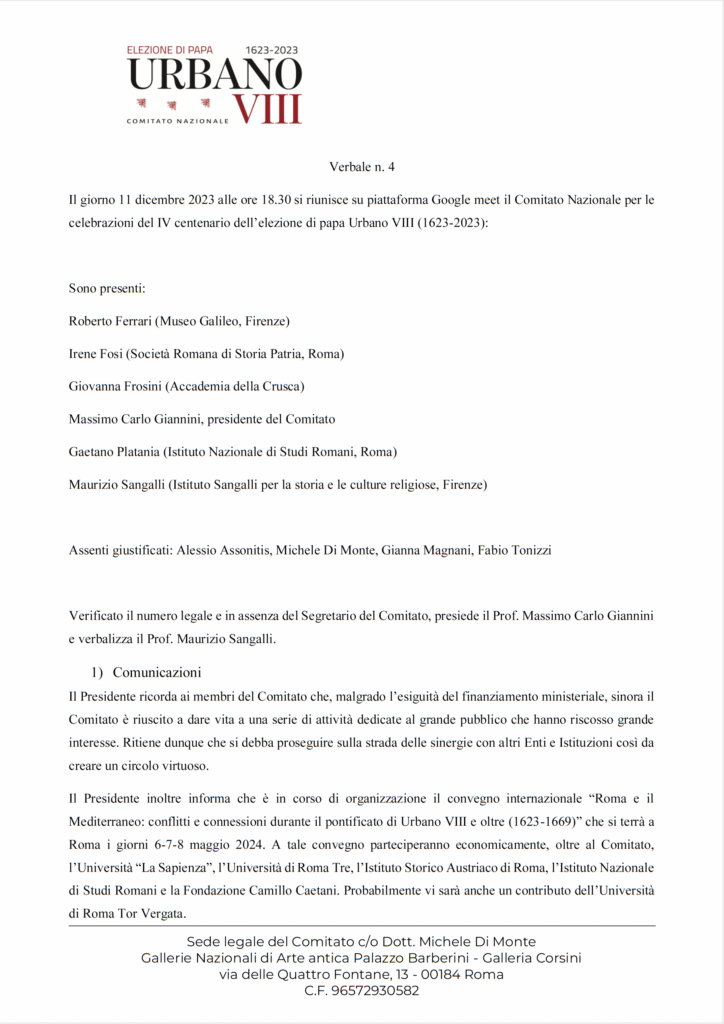
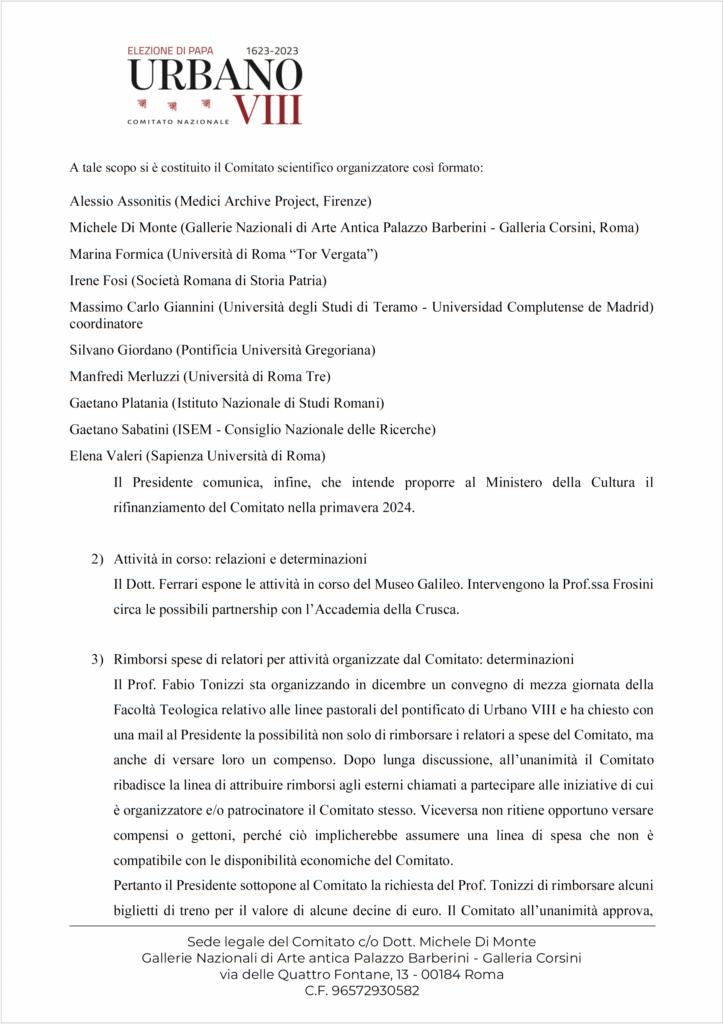
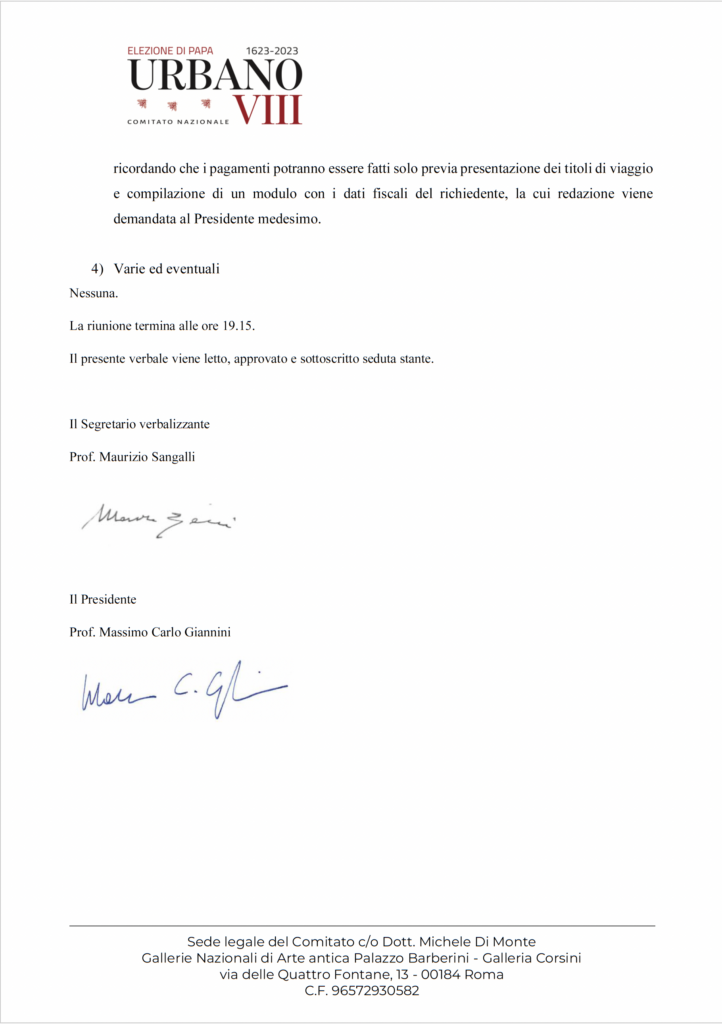
Membri del Comitato Nazionale
Massimo Carlo Giannini, Presidente del Comitato
Alessio Assonitis (The Medici Archive Project, Firenze)
Michele Di Monte (Gallerie Nazionali di Palazzo Barberini e Corsini, Roma)
Roberto Ferrari (Museo Galileo, Firenze)
Irene Fosi (Società Romana di Storia Patria, Roma)
Giovanna Frosini (Accademia della Crusca)
Gianna Magnani (Comune di Barberino Tavarnelle)
Gaetano Platania (Istituto Nazionale di Studi Romani, Roma)
Maurizio Sangalli (Istituto Sangalli per la storia e le culture religiose, Firenze)
Fabio Tonizzi (Facoltà Teologica di Firenze)
RSA 2024
RSA Panel on Aristocratic Women
Organized by the Medici Archive Project
Chair: Sheila ffolliott
Contact: Carla D’Arista. cad2102@columbia.edu
Behind Every Great Man is a Strong Woman:
Noble Wives and Courtly Mistresses in Early Modern Europe
With the exception of select patronage and portrait studies, the lives and legacies of the wives, mothers, consorts, and mistresses of the Medici and other aristocratic dynasties in early modern Europe have received relatively short shrift. This panel seeks to fill in some of the gaps in our knowledge of such figures as Clarice Orsini, Taddea and Ricciarda Malaspina, Pacifica Brandani, Madeleine de la Tour d’Auvergne, Filiberta of Savoy, Maria Salviati, Camilla Martelli, Maria Maddalena of Austria and Marguerite Louise d’Orléans. Archival studies and a closer examination of visual and material evidence of the roles of these women as social and political mediators would complement existing studies of their representations in Italian art. This panel invites submissions on individuals as well as related issues of the dynastic and political strategies associated with these unions. Treatment of the upbringing of children born of those relations are also welcome.
The Art of Negozio
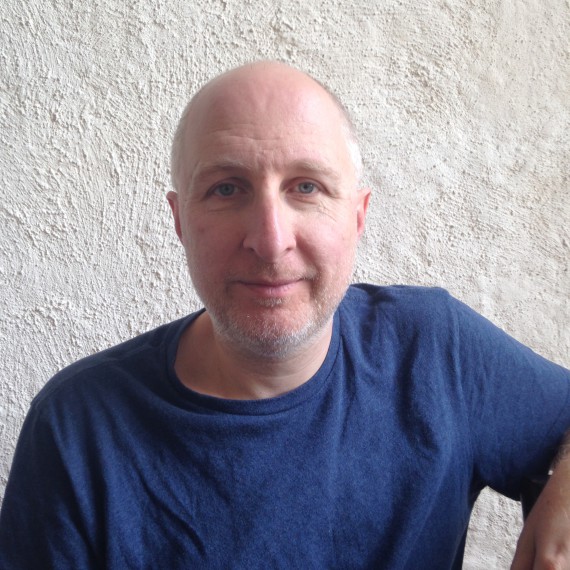
Premise
Inspired by the personal and public trajectories of the Medici family and the Renaissance, The Art of Negozio project was created by Artur Kluz with funding from Kluz Ventures. The project envisions becoming the catalyst for a new generation of global leaders, entrepreneurs, and venture capitalists to focus on and contribute to human flourishing. While we take inspiration from the past, we live for the future, while maintaining a moral obligation to protect Tradition and to pass the flame of virtue to future generations.
Unquestionably we are living in an era of unparalleled technological revolution, where technology is the fundamental driver of social transformation and growth; leading to the reimagination of everything.The Art of Negozio project intends to identify the multiple strains of negozi that marked the rise of Medici financial and political hegemony and translate them into a cogent contemporary compass. This project will address the following questions: What was the impact of technology on Renaissance finance? What were the modes of self-representation and how were they disseminated locally and globally? What kind of governmental systems proved to be more congenial to progress? How did financial growth affect political stability and instability? What survival strategies were applied during periods of crisis? What constituted a crisis in the Renaissance? How did familial priorities merge into state building? What were the rules of engagement? What was the index of ethical and/or moral possibilities in the construction of wealth? What were the benchmarks of success? And what were the cautionary tales?
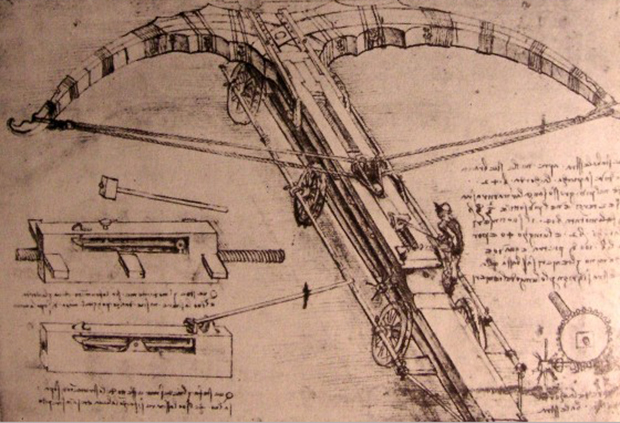
These concepts, which have shaped the course of Western culture, will be investigated with respect to contemporaneity. What lessons can be learned from the Medici (and non-Medici) experience? Can Medici individuality serve as an inspiration to—or even a model for—today’s venture capitalists and entrepreneurs?
The exponential creative and financial revolution that took place in Silicon Valley during the past fifty years will serve as a case study. Aside from the basic similarities between these two ‘renaissances’, the Art of Negozio project will take stock of the Medici experience to inform and, to a greater extent, enhance the personal strategies and collective trajectories of future leaders, innovators, venture capitalists, philanthropist, communicators, and globalists. Important lessons can be learned from the Medici legacy. The moral question will be brought to the fore and recalibrated through the lenses of a series of thematic dichotomies which were urgent in Renaissance Florence as they are in twenty-first century Silicon Valley: progress and sustainability; proper conduct and realpolitik; opportunity and controlled risks; dissemination of knowledge and covert research; innovation and tradition; preservation and redistribution of wealth. The summa of these investigations will produce an impressive vade mecum for the contemporary entrepreneur. To borrow Grand Duke Cosimo I de’ Medici’s personal motto—festina lente (“make haste slowly”)—the Art of Negozio project will redefine Renaissance standards of virtue (especially temperance, prudence, and fortitude but also vigor, initiative, and energy) into a programmatic pandect that will help to form new leaders who will write a new history of the future.
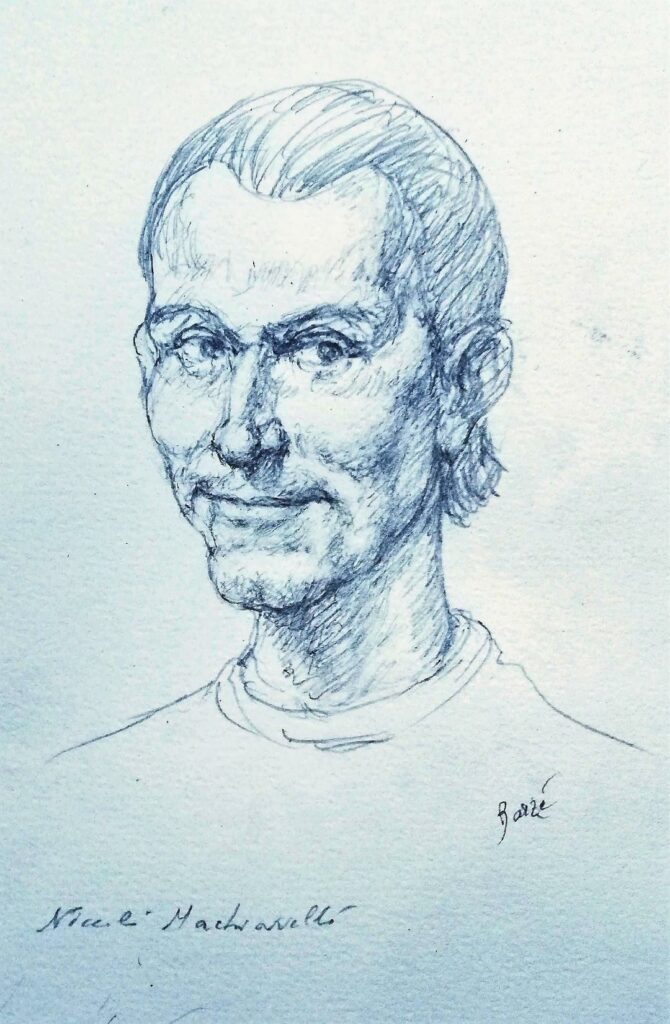
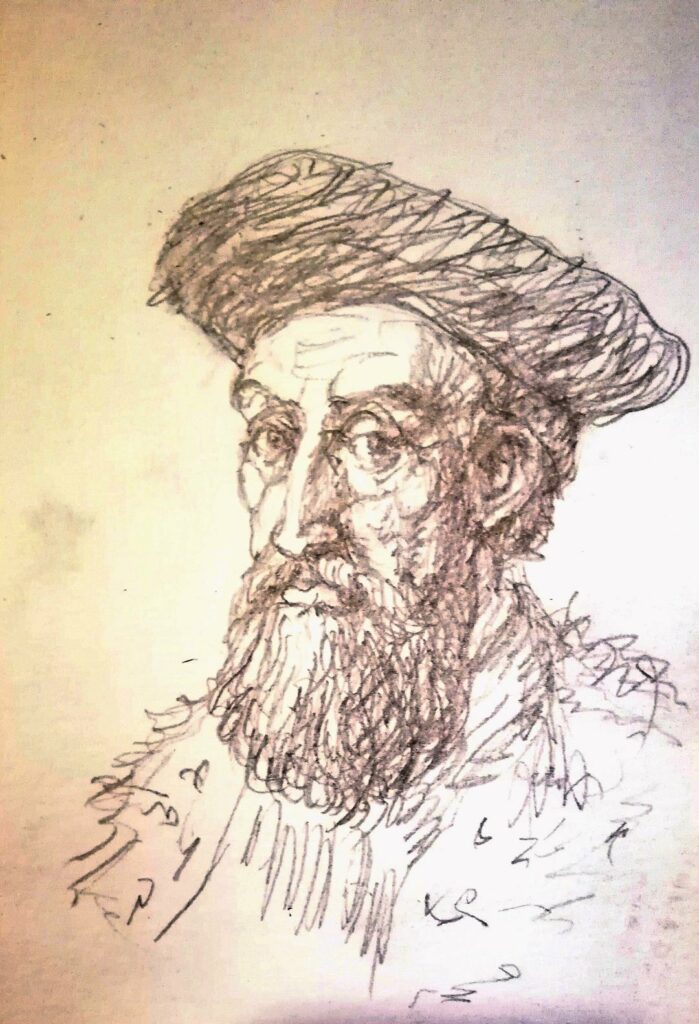
Historical Background
In the fifteenth century, when the Medici were principally known for their mercantile and banking activities, the term negozio—from the Latin, negotium, meaning “activity” and “occupation”—had obvious financial connotations. In their correspondence, negozio had multiple meanings: a business deal, a simple or complex banking transaction, a commercial negotiation, a reimbursement, a loan, etc. However, this word began to acquire more diverse meanings according to the specific context in which it was used. From a more emotional perspective, it meant difficulty, preoccupation, or frustration. In the field of jurisprudence, it indicated a court trial or a lawsuit. More philosophically, it conveyed a situation, an event, or a circumstance.
In Machiavellian Italy, negozio acquired a more political significance. The Prince, in so many ways, recalibrated this term and situated it within the context of state-building and leadership. In other words, negozio was the means with which to survive Renaissance realpolitik, and The Prince became a manual about how to conduct diplomatic, financial, legal, and administrative transactions: precisely, the art of the negozio. In Chapter Seven of The Prince, Machiavelli defines two kinds of princes: “by virtue” and “by fortune”. The first is a self-made man, who achieved success through his own efforts; the second is someone who, having been born into a position of privilege, was able to increase his own political capital.
Machiavelli showed that in order to achieve personal success, one needs to be ruthless without following commonly accepted moral principles. He inaugurated modernity by issuing the divorce between ethics and politics. On the other hand, the true beginning of the modern era occurred with the marriage between politics and finance.
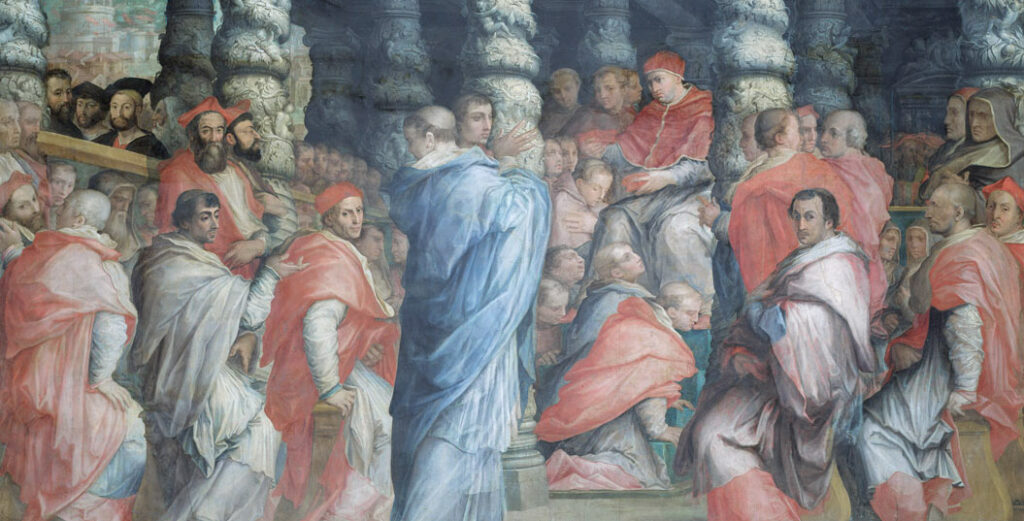
Money had always been at the root of power: but self-awareness and new financial tools had their roots in Florentine banking tradition. The Medici were not the only banking family: the Albizzi, Pazzi, and Strozzi also played major roles. However, while the first two clans were defeated in bloody internecine conflicts, the Strozzi, in the early sixteenth century, became an ally of the Medici. The person who embodied this formidable alliance was Filippo Strozzi—a close friend and patron of Machiavelli—who financed the publication of The Prince. Filippo, who married Clarice de’ Medici, served at same time as treasurer of Florence and as treasurer of the Apostolic Chamber in Rome, under the two Medici Popes Leo X and Clement VII. In his double role, Strozzi—one of the richest men of his time and a true master of the negozio—quietly moved about four million ducats (roughly two/three billion of today’s dollars) from the Florentine taxpayers into the Church’s coffers. It is thanks to this ruthless financial operation that the Medici established themselves, from simple bankers, as a major ruling dynasty in Europe.
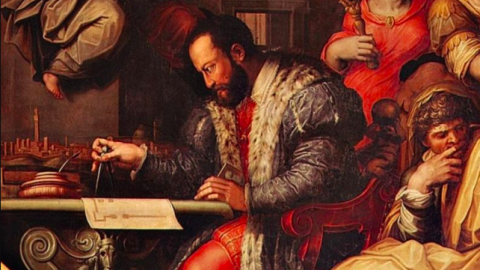
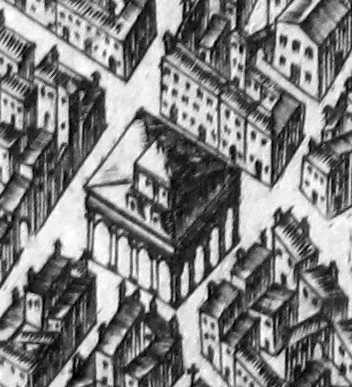
The member of the Medici dynasty who successfully channeled all the different modes of negozio into one modus operandi was without doubt Cosimo I de’ Medici, who ruled Tuscany from 1537 to 1574. Coming from the minor branch of the Medici family and having suffered a difficult childhood, Cosimo was elected duke at the age of seventeen, at the time when Florence was recovering from internecine political turmoil and from the malgoverno of an ineffective leader, Alessandro de’ Medici.
In the years following his accession, Cosimo defeated the Strozzi, who had turned against his rule calling it tyrannical, and managed to successfully restore Florence to its former glory. Through a series of effective and sometimes radical reforms—also a form of negozio—the young Medici scion established institutional and administrative stability; financial prosperity through targeted investments; diplomatic and information networks; solid infrastructure and fluid communications systems; modes of self-representation and cultural dissemination; technological and scientific advancements. In many ways, Cosimo’s innate entrepreneurial talent, his survival strategies, his ability to decipher the political, diplomatic, and financial opportunities of early modern Europe (and have them serve familial priorities) paved the way to the two-hundred-year prosperity of the Medici Grand Duchy.
FOOD! Workshop (20 January 2023)
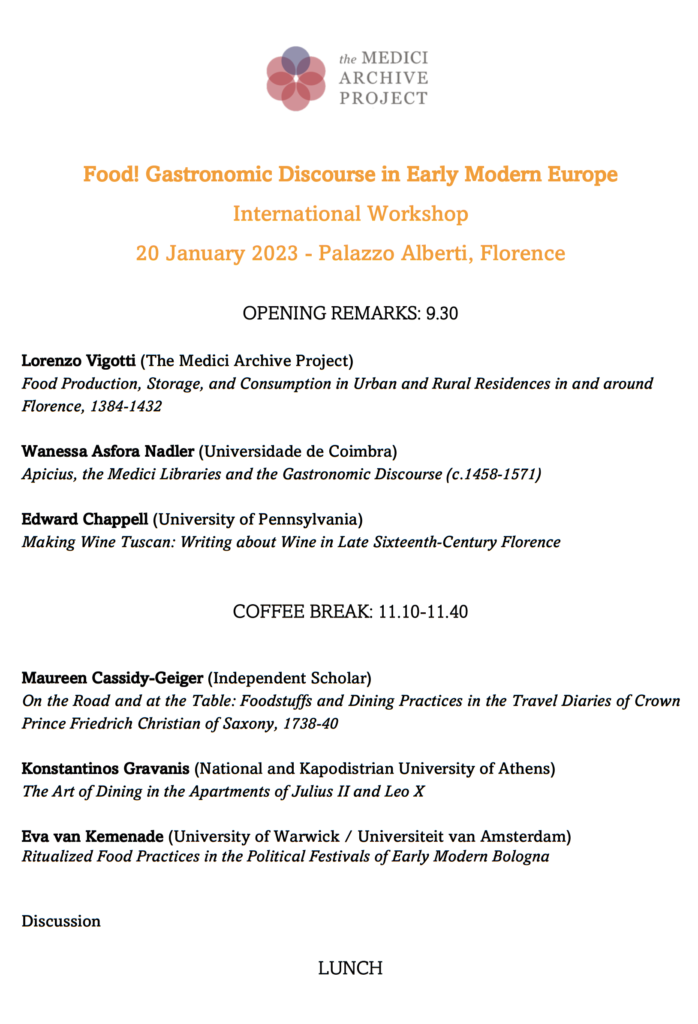
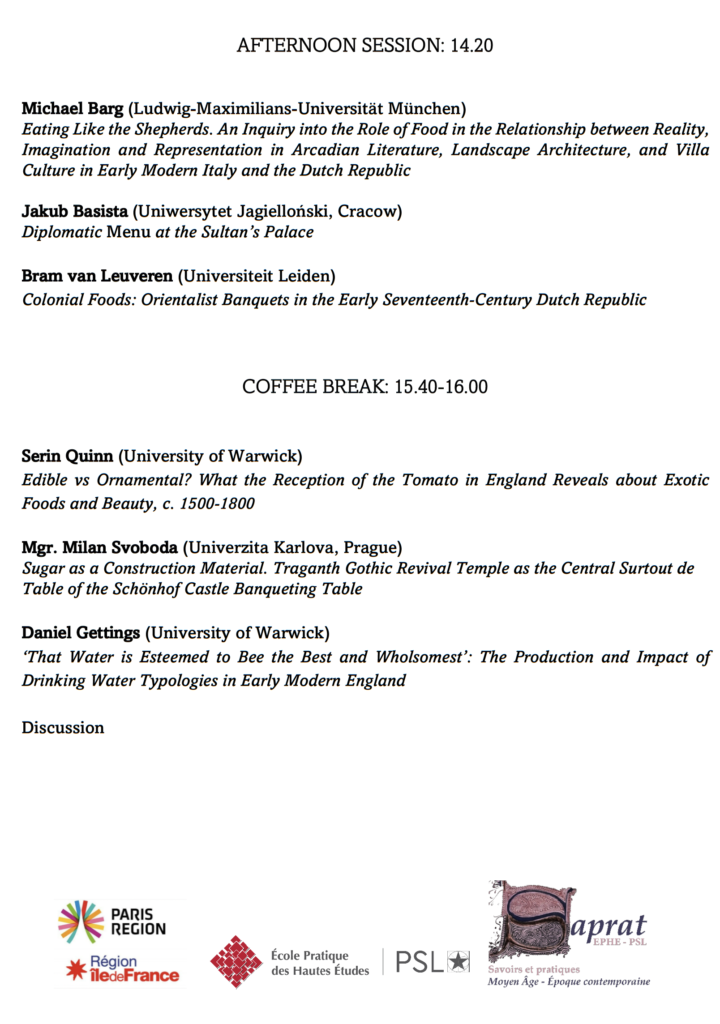
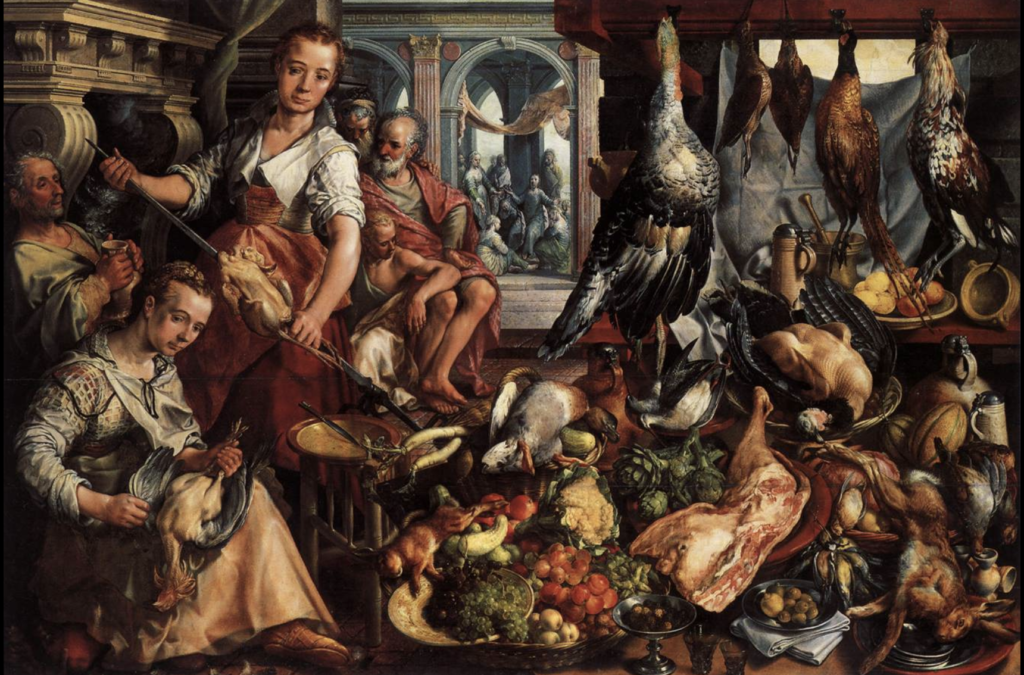
CALL FOR PAPERS
Food provides an ideal starting point for bridging scholarly discourse between different fields of study and disciplines. It also provides an index of research possibilities and elaborate narrative paths that link together urban and rural contexts, the sophistication of the courts and the simplicity of the peasant table; botanical studies and agronomical practices; cookbooks and trade of exotic products; and diets and famines.
The organizers of this workshop (Maddalena Bellavitis and Alessio Assonitis) invite papers that address issues that can shed new light on aspects of daily life and culture in early modern Europe. Special attention will be given to new interdisciplinary research trajectories on any topic that can be connected with food, including: food acquisition, preservation, preparation, and presentation; descriptions of meals (including table decoration and service); specific dishes and notable ingredients; importation, cultivation and processing of new or exotic foodstuffs; restricted or ritualized food consumption, including fasting for religious or health reasons; popular beliefs regarding the special properties of foodstuffs; and gift-giving culture and global commerce.
For this reason, we encourage submissions for presentation proposals from scholars working in the humanities, but also in the fields of agronomy, viticulture, social history, oral history, and technology.
To be considered, please send a single document in Microsoft Word, consisting of a one-page proposal for a 20-minute presentation of unpublished work, followed by a one-page curriculum vitae. Presentations will be in English. Applications may be sent to education@medici.org by 22 October 2022 (participants will be notified by November 22).
